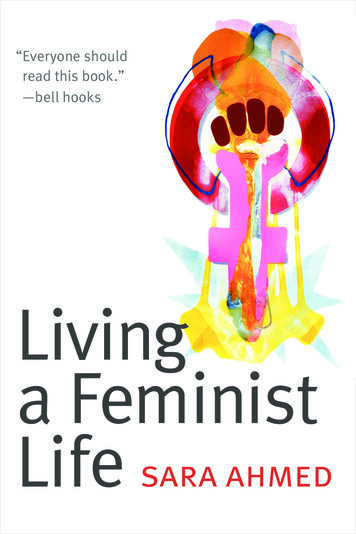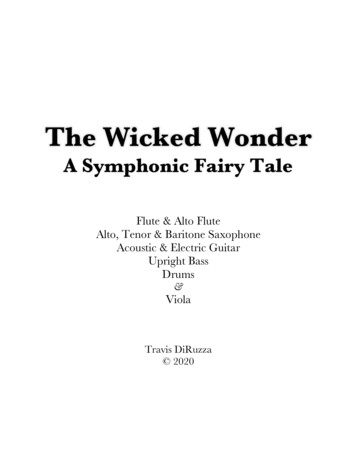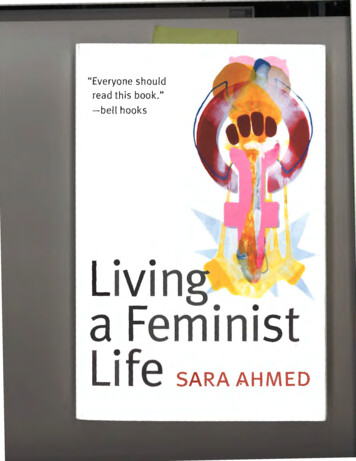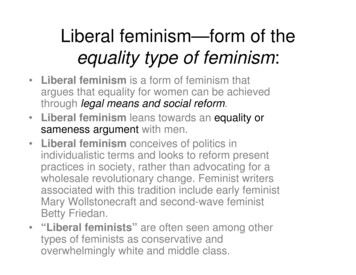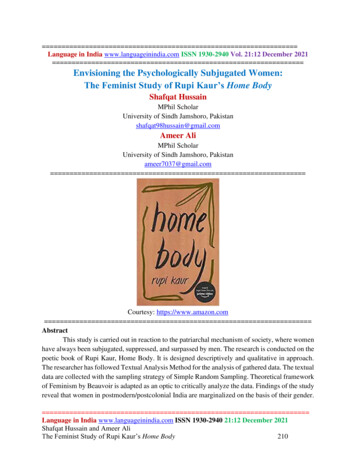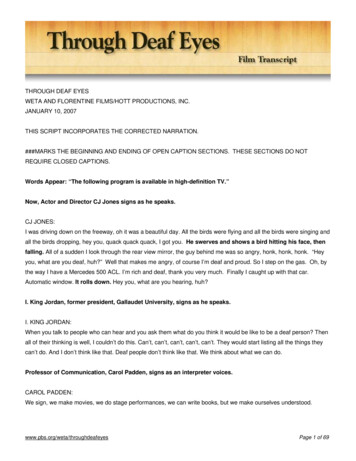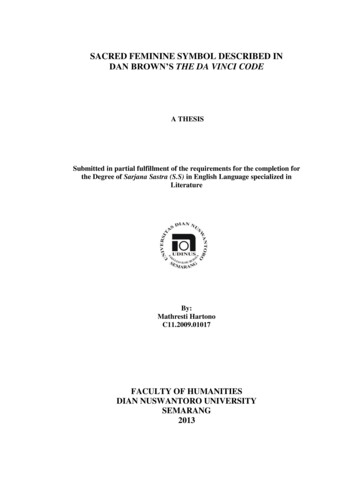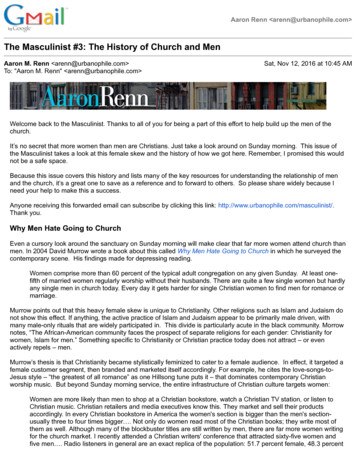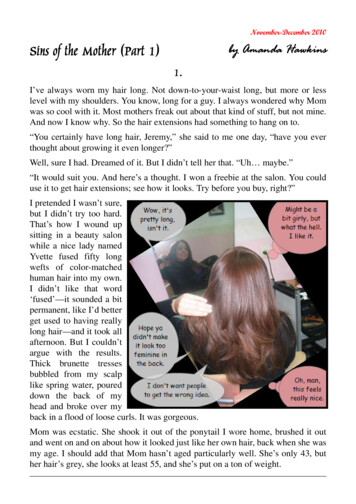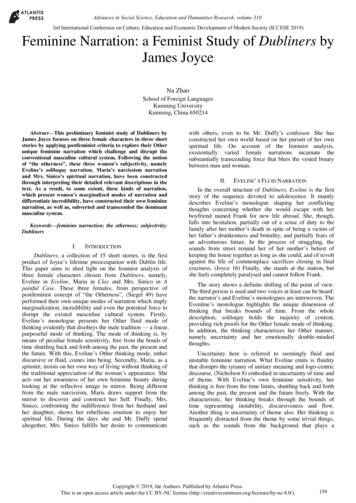
Transcription
Advances in Social Science, Education and Humanities Research, volume 3103rd International Conference on Culture, Education and Economic Development of Modern Society (ICCESE 2019)Feminine Narration: a Feminist Study of Dubliners byJames JoyceNa ZhaoSchool of Foreign LanguagesKunming UniversityKunming, China 650214Abstract—This preliminary feminist study of Dubliners byJames Joyce focuses on three female characters in three shortstories by applying postfeminist criteria to explore their Otherunique feminine narration which challenge and disrupt theconventional masculine cultural system. Following the notionof “the otherness”, these three women’s subjectivity, namelyEveline’s soliloquy narration, Maria’s narcissism narrationand Mrs. Sinico’s spiritual narration, have been constructedthrough interpreting their detailed relevant descriptions in thetext. As a result, to some extent, these kinds of narration,which present women’s marginalized modes of narration anddifferentiate incredibility, have constructed their own femininenarration, as well as, subverted and transcended the dominantmasculine system.Keywords—feminine narraction; the otherness; subjectivity;DublinersI.INTRODUCTIONDubliners, a collection of 15 short stories, is the firstproduct of Joyce’s lifetime preoccupation with Dublin life.This paper aims to shed light on the feminist analysis ofthree female characters chosen from Dubliners, namely,Eveline in Eveline, Maria in Clay and Mrs. Sinico in Apainful Case. These three females, from perspective ofpostfeminist concept of “the Otherness”, (Siegel 49) haveperformed their own unique modes of narration which implymarginalization, incredibility and even the potential force todisrupt the existed masculine cultural system. Firstly,Eveline’s monologue presents her Other fluid mode ofthinking evidently that disobeys the male tradition — a linear,purposeful mode of thinking. The mode of thinking is, bymeans of peculiar female sensitivity, free from the bonds oftime shuttling back and forth among the past, the present andthe future. With this, Eveline’s Other thinking mode, ratherdiscursive or fluid, comes into being. Secondly, Maria, as aspinster, insists on her own way of living without thinking ofthe traditional appreciation of the woman’s appearance. Sheacts out her awareness of her own feminine beauty duringlooking at the reflective image in mirror. Being differentfrom the male narcissism, Maris draws support from themirror to discover and construct her Self. Finally, Mrs.Sinico, confronting the indifference from her husband andher daughter, shows her rebellious emotion to enjoy herspiritual life. During the days she and Mr. Duffy spendaltogether, Mrs. Sinico fulfills her desire to communicatewith others, even to be Mr. Duffy’s confessor. She hasconstructed her own world based on her pursuit of her ownspiritual life. On account of the feminist analysis,existentially varied female narrations incarnate thesubstantially transcending force that blurs the vested binarybetween man and woman.II.EVELINE’ S FLUID NARRATIONIn the overall structure of Dubliners, Eveline is the firststory of the sequence devoted to adolescence. It mainlydescribes Eveline’s monologue shaping her conflictingthoughts concerning whether she would escape with herboyfriend named Frank for new life abroad. She, though,falls into hesitation, partially out of a sense of duty to thefamily after her mother’s death in spite of being a victim ofher father’s drunkenness and brutality, and partially fears ofan adventurous future. In the process of struggling, thesounds from street remind her of her mother’s behest ofkeeping the house together as long as she could, and of revoltagainst the life of commonplace sacrifices closing in finalcraziness. (Joyce 16) Finally, she stands at the station, butshe feels completely paralysed and cannot follow Frank.The story shows a definite shifting of the point of view.The third person is used and two voices at least can be heard:the narrator’s and Eveline’s monologues are interwoven. TheEvenline’s monologue highlights the unique dimension ofthinking that breaks bounds of time. From the wholedescription, soliloquy holds the majority of content,providing rich proofs for the Other female mode of thinking.In addition, the thinking characterizes her Other manner,namely uncertainty and her emotionally double-mindedthoughts.Uncertainty here is referred to seemingly fluid andunstable feminine narration. What Eveline emits is fluiditythat disrupts the tyranny of unitary meaning and logo-centricdiscourse, (Nicholson 8) embodied in uncertainty of time andof theme. With Eveline’s own feminine sensitivity, herthinking is free from the time limits, shuttling back and forthamong the past, the present and the future freely. With thecharacteristic, her thinking breaks through the bounds oftime representing instability, discursiveness and flow.Another thing is uncertainty of theme also. Her thinking isfrequently distracted from the theme by some trivial things,such as the sounds from the background that plays aCopyright 2019, the Authors. Published by Atlantis Press.This is an open access article under the CC BY-NC license 59
Advances in Social Science, Education and Humanities Research, volume 310significant role in presenting her Other mode of thinking.Her attention is usually diverted and paid to some trivialthings that appear her mind accidentally. Then, naturally, herthinking is flowing with what she hears.Evenline’s chain of thinking is continuously woven in theconception of the past, the present and the future. Initially,sitting at the window, she is caught in meditation. When shehears someone passing, she begins at once to recall her pastchildhood that is brought into mind during her pondering thefootsteps. And then, her thinking is drawn from the previousexperience to the reality. She knows that she, her brothersand sisters are all grown up, her mother died, Tizzie Dunndied too, and the Waters went back to England. Everythingchanges. (Joyce 23) Until that moment, her thoughts justcome back to the point, leaving her home for Frank. At thesame time, she is looking around for home, a yellowingpriest photograph draws her attention, and simultaneouslyher father’s words come into her mind. Her thinking isalways lingering between the past and the present, from thepicture to the words by her father. Furthermore, she recallsher treatment from her father at present but frequently insertsher earlier maltreatment she experienced. Now, she feelssometimes herself in danger of her father’s violence. (25)She gets nobody to protect her in reality. Slowly, her thoughtfalls into the detailed experiences, such as the invariablesquabble for money, hard work to keep the house together,etc. On the other hand, she is, as a matter of fact, involved inhesitation about her elopement with Frank. Seeminglymeanwhile, she is dreaming about her new life and depictionof a blueprint in details with Frank. Only in this way, herdecision has been strengthened heading for a new life.Eveline’s yearning for change shows in her memories of thepast, pondering of the present and imagination of the future.Recalling her romance with Frank and her father’s attitudetowards their affair, Evenline’s thinking returns to the reality.After she made decision, standing at the station with Frank,she is thinking of her future fate but uncontrollably recallingback to the past and falling into the condition by now. Fromdiscussion above, her thinking is manifested apparently inher memories, her pondering and her imagination. The modeof thinking is free from the constraints of time bounds,shifting freely from the past, the present and the future.Moreover, uncertainty of theme is also exhibited in herOther feminine narration, which is caused by her sensitivityto the sounds from the background. (Beauvior 146) Eveline,to a certain extent, is distracted by a casual sound and herthoughts may follow the sound unconsciously so that herthinking has been shifted from one topic to another. In theprocess of consideration, due to her sensitivity, her thinkingis frequently decentralized by some trivial things, whichmight have nothing to do with her points to make decision.The influence of the sounds infers her sensitivity to trivialthat embodies her peculiar feminine narration. At first, she issitting at home, and may not think about anything (nothing ismentioned in the text). But when she hears the footstepsfrom the background, she begins to follow the tracks of thesound unconsciously. For it, she recalls the earlierappearance of the field where her companions and sheplayed every evening. The footsteps provide the hints for herto bring her memories back. Bring the time when she was achild and her mother was still alive. And then, her thinkingcontinues to recall the changes of the field. And she bringsher thinking back to the present, looking around the roomshe is in. One picture has caught her attention, and then shebegins to think over who is the priest. But when her father’swords came into her mind, immediately, her thinking isshifted to her decision about escape. The association fromthe photograph, as an interlude, is resulted in the divergentthinking present in her leaping and unstable thinking.Furthermore, although at the time leaving for station isapproaching, she is still sitting by the window thinking abouther father might not as bad as she thinks. At the same time,she can hear a street organ playing down far in the avenuewhile indulging in her re-judging her father. Following themusic, her promise to her mother appears in her mindreminding her of the responsibility for the family as theeldest child. The music reminds her of the moment hermother is dying. As she thinks back the pitiful vision of hermother’s life, she trembles as she hears again her mother’svoice saying constantly with foolish insistence. That impliesher thinking is easily distracted by the sound which is similarto what she hears before. The casual music, as a reminder,gets her mind to focus on her experience and unpleasantundergoing, which reflects her difficult choice. With theinfluence of the background sounds, her thinking is flowingfreely in her own dimension, so Evenline’s uncertainty oftheme represents fully Other fluidity in her thinking.Thirdly, Evenline’s double-minded thinking undoubtedlyserves for her feminine demonstration of the fluid mode ofthinking. On the whole, she is confronting a question of “tobe or not to be”. Between the family and her completely newlife, her mode of thinking displays hesitation, and it isescaping from masculine arbitrariness. Without reaching theextremity, her thinking represents the fluidity, which carriesfemale emotionalism proposed by Simone de Beauvior. Thislack in stability and control underlies woman’s emotionalism.(152) Before making a choice, Evenline tried to weigh eachside of the question. Thus she never puts each side to theextremity but leaves aside some space to each side of aquestion because she frequently considers the questions withher own emotions. Once one side of a problem in herthinking becomes overweight, her thinking would bewithdrawn towards another side. In her double-mindedthinking, her mode of thinking has been exhibited with herambivalent feelings. Every time she thinks over a matter, hermind inevitably is swinging back and forth between twosides. Originally, her first sentence accounts for her father’sbrutality and violence at that moment, and yet her thinking isturning to another side — her father occasional kindnesstowards her. With it, her father’s image is lingering betweenthe violent and the kind one, and between the badness andthe goodness. She is struggling between her affection for herfather that exists innately and her abhorrence that she livesunder the shadow of her father’s violence. Eveline’s thinkingcontinuously sways between the bad faith and the good faith.Her father’s image, a typical patriarchal male, a brutal andviolent but occasionally nice father, has come into beingamong her double-minded thinking.160
Advances in Social Science, Education and Humanities Research, volume 310Therefore, Evenline’s thinking is fluid. Following postfeminist conception of the Other, female can construct hersubjectivity in her Other manner by ignoring the maleconventions. The pioneer Simone de Beauvior proposes tification of woman, the most obvious reversal wouldbe to objectify man. (Raman Selden 159) Evenline’ssoliloquy breaks through the bounds of time and theme. Herdivergent and double-minded thinking is free from the linearmasculine thinking focusing on one thing to produce alogical analysis according to the hierarchical relationship.(Foucault 226)III.MARIA’S NARCISSIST NARRATIONMaria is the leading role in Clay, the shortest story in thecollection. The story is about a popular and ancientdivination game played on All Hallow’s Eve. Various itemsare arranged and a blindfolded person has to choose one ofthem. Generally, a ring is included and if a woman touches it,this is a sign that she would marry in the following year; Ifshe touches a prayer book, she would go into a convent;Traditionally, if touches a piece of clay, she would die.Maria, the heroine, is employed at Dublin by Lamplightinstitution as a laundry. On Halloween day she takes a tramto the Pillar and goes shopping nearby. She buys some candyfor children and some plum-cake for the Donnellys. Butunfortunately she leaves the cake on the tram and then sheboards another tram going north towards Drumcondra andgets off at the Canal Bridge. Finally she arrives at Donnellys’house, her brother’s family, with some candy. Taking withJoe for a while, Maria is invited to participate in the game.Blindfolded Maria is led to the table to see what she wouldget. She touches a soft wet substance that is clay. Althoughshe is given another chance to play after a while, the storyends with a gloomy song.Maria’s existence, as a spinster, conveys a potentiallytranscending force over the male conventions. In themasculine system, according to the post-feminist notions,men generally consider a spinster as a narrow-minded anddetestable woman who is the object independent from themale value. (Kimmel 286) Men assert women must finallyfall back to marriage and family being as a part of husbands’possession. Consequently, for a virgin, who is not conqueredby a man to step off from the marriage, men take her as awitch.(Foucault 232) Maria does not marry anyone so, inmen’s view, she has become a monster, a crazy person thatpeople are unable to communicate with and would stay at adistance from the male dominance. In the story, Maria is theother woman who liberates herself from the range of themale domination, at least from the marriage.In addition, Maria’s appearance, from the very fewsentences, presents an image of witch who has very longnose and a very long chin, appears on Halloween day. Tosome extent, Maria’s image rightly satisfies the malestandard evaluation about a spinster. For Maria, anunmarried woman, the reality is that she is at the state ofOther opposite to the masculine ideology. Furthermore,Maria is willing to fall in love with herself, which manifestsher narcissism that is more disruptive to the male traditions.Female narcissism indeed is different from the male. Manthinks and hopes he is the subject in the world and thereby heshould be acting in an initiative way. Consequently, hewould not observe himself and find Self by means of mirrorand might have no interest in mirror to show his initiative.Woman, however, is impelled to find her superiorimportance in her own world. Then, finally, she has becomeher own subjectivity by inspecting herself in mirror. Byobserving herself in the mirror, she can obtain confidence tobuild up her otherness to realize her narcissism and toestablish her own subjectivity. In Maria’s narcissism, shepresents her satisfaction towards her image in mirroralthough she is not young and pretty in man’s eyes. For man,woman’s pretty appearance is her possession that worldacquire the male favor and at the same time it is the capitalso that woman can rely on man. (Kaminer 9) Opposite to themale traditions, Maria doesn’t take this point of view. Inmirror, Maria has discovered and enjoyed her enchantment.And even she demonstrates the tendency of narcissism,which promotes her to construct her Self in the process.Apparently, the tendency to be a narcissist is evident inthe story. Despite her body has been branded with thechanges of years, she still has found “a nice tidy little body”.Her affection for her appearance has not reduced in theseyears and her subjectivity has been under construction aswell. In mirror, she constructs her own subjectivity to realizeher femininity. In addition, her femininity has been projectedin her daily life. Maria is portrayed as a woman who is goodat housework. From it, her femininity as a housewife ismanifested; her maternal image comes into being when sheis nursing Joe and Alpha; what’s more important is herexcitement is popped out when she proves as aneconomically independent woman. Moreover, therecognition from people around Maria supplies thepossibility for her to be a narcissist. Maria is a warm-heartedand competent woman. She can cut these barmbracksperfectly that seemed uncuttable. She is a peace-maker sinceshe was always sent for when the women quarreled overtheir tubs and always succeeded in making peace. In thestory, everyone is so fond of Maria. To a certain extent, theappraisal like that has represented her existential value.Furthermore, her attitude toward marriage and her caringfor her brothers incarnate her indifference to a ring or a manand her unique femininity as well. Firstly, before Maria goesto Joe’s house, her colleague Lizzie Fleming says to her thatshe is sure to get the ring. Although Fleming has said that forso many Hallow Even, Maria has to laugh and says shedoesn’t want any ring or man either.(Joyce 152) Whensitting on the tram on her way, she is falling into ponderingthat she arranges in her mind all she was going to do, andthought how much better it was to be independent and tohave her own money in her pocket. (159) Obviously Mariaenjoys her independence and, with her present condition, shehas stood out of the male domination and found her femalesubjectivity in her Other position as a woman. On the otherhand, Maria exhibits her unique femininity when dealingwith her brother Joe and Alphy. She recalls the happy timewhen they are together and hopes such beautiful time can beback again. She nursed Joe and Alphy before while she is161
Advances in Social Science, Education and Humanities Research, volume 310unmarried. So Joe often says mamma is mama but Maria ishis proper mother. (160) In this way, she has experiencedwhat a married woman would undergo — to be a mother. Asa result, on this special occasion, she has put much attentionto the job, the relatives and the life but to find a man.Therefore, Maria’s affection for her appearance, herindependence, her attitude toward marriage and her uniquefemininity make her attain support from the mirror andincline to being narcissistic with the image in the mirror. Notsimilar to man, woman achieves self-fulfillments by meansof her own immanence. (H. M. 45) In mirror, her own space,she confirms her immanence, which is transferred into a kindof transcendence for her to achieve her subjectivity. Thistranscendence reflects the force going beyond the prejudicethat man and most of woman hold in reality. Whenconfronting with marriage urge, her eyes sparkle withdisappointed shyness, which makes her realize the necessityof rediscovering her own self. Before the mirror, observingher appearance and body she finds her real self in this stillobject. Standing before the mirror, Maria recalls her imagewhen she was a young girl, thinking about her peculiarenchantment. Although the youth never comes back, sheprojects her satisfaction about her young image on thepresent image in mirror. Following this way, she falls in lovewith herself as she can find her own identity that she wantsto show her subjectivity in mirror. Maria constructs her lovefor herself by discovering her Self in the mirror.IV.MRS. SINICO’S SPIRITUAL NARRATIONThe first section of the story, A Painful Case is devotedto the presentation of the meeting between Mr. Duffy andMrs. Sinico at concerts. And then they make appointmentsregularly at her home. Their friendship grows, as he shareshis intellectual life with her. But one night, she makes themistake of catching up his hand passionately and pressing itto her cheek. Then, he leaves her. Four years later, Mr. Duffyreads in the paper of Mrs. Sinico’s death that she has beenknocked down by a train while crossing the line at a stationin a state of intoxication. At time moment, Mr. Duffy’s firstreaction is one of disgust at such intemperance, and of selfrighteousness. But on second thoughts, he feels ill at easeand after a bit of self-pity and realizes the burden ofloneliness.Simone de Beauvior proposes that it is not nature onwoman’s own account in her emotional life. Woman’semotional life within the constraints of a situation where shefinds herself treated as the Other, attempts to draw out theontological meaning of these emotional attitudes. (Butler For:310) In male world, man insists woman should sacrificeherself to engage in the family so as to make her as asubordinated woman. For a woman, what she should pursueis to get man happy and ignore her own feelings. However,Mrs. Sinico has been struggling for her own way of living.Her pursuit is mainly manifested in the days when gets longwith Mr. Duffy. Although she lives in a rich life supportedby her husband, she notices, as a woman, she still has theright to get her spiritual world besides a material one. She isaware that she is not an object but a woman who has her ownthinking capability. She indeed enjoys the spiritual worldthat she and Mr. Duffy have created but later, due to herpassionate behavior, she has to confront the hindrance on theway of pursing her spiritual world. And then, she is addictedto her spiritual life with her other manner — drinking thespirits. With her other mode of pursuit, however, she lives inher own spiritual world without man. Under the state ofdrunken she really rejects the male view of Otherness thatman has endowed her with to set up her subjectivity.Mrs. Sinico is not a woman who yields up to her fixeddestiny easily. Firstly, during the first meet with Mr. Duffy,her potential struggle is portrayed through Mr. Duffy’s eyes.Mrs. Sinico’s eyes were very dark blue and steady. Theirgaze begins with a defiant note, but is confused by whatseems a deliberate swoon of the pupil into the iris, revealingfor an instant a temperament of great sensibility. She knowsshe has a mind as men do to enrich her spiritual world. At thefirst meet at the concert in Earlsfort Tefface, Mrs. Sinicoshows her initiative that she starts talking at first. At thatmoment Mr. Duffy feels surprised that she seems littleawkward. A few weeks later, they meet again. Mr. Duffyseizes the moments to talk to her covering the topic about herfamily. Then, meeting her at the third time by chance, Mr.Duffy finds the courage to make an appointment. Finally,they always meet in the evening and choose the quietestquarters for their walk together. What’s more is he lends herbooks providing her wither ideas and sharing his intellectuallife with her. In this process, she has constructed her ownspiritual life and expressed herself by reading books,accepting different ideas and sharing her opinions with himfrankly. And gradually, she is aware of her subjectivity byholding a leading position to influence on Mr. Duffy in theircommunication. Little by little, he entangled his thoughtswith hers. Furthermore, Mrs. Sinico creates her own spiritualworld in her own way. Many times she allowed the dark tofall upon them, refraining from lightening the lamp. The darkdiscreet room, their isolation, the music that still vibrated intheir ears united them. She establishes her own space so as toimagine her desirable life and self-examine what she has saidand done. In the darkness, she can gallop in her imaginationlike being in another world, and escape from the tradition,from her husband’s indifference and her daughter’smisunderstanding. In her spiritual world, she is the owner ofherself to make her inner world filled with vitality throughcatching herself listening to the sound of her own voice. Andher voice for struggle can be heard in this fancy of darkness.She constructs her own spiritual world in which she obtainsher freedom and finds her subjectivity. Thirdly, Mrs.Sinico’s death implies the climax of her pursuit to achieveher own spiritual world. Mrs. Sinico’s death is reported inthe newspaper four years later since she separated from Mr.Duffy. From the narration about her recent conditions told byher family, she is frequently drunk. Her husband mentionsshe begins to be rather intemperate in her habits, and herdaughter witnesses her mother has been in the habit of goingout at night to buy spirits. After the separation from Mr.Duffy, she still knows what she wants is to get spiritualconcerns, so she changes her way to fulfill her pursuit. Inreality, she fails to build up her spiritual life with Mr. Duffy.In Other way, she continues her pursuit to be a state ofdrunkenness. Drawing support from spirits, she acquires her162
Advances in Social Science, Education and Humanities Research, volume 310freedom in the darkness. In the spiritual world, she createsherself and liberates herself from male-dominated society.With that, she is able to release her emotions, her family’sindifference and even Mr. Duffy’s disgusting responsecounts little to dominate herself in the spiritual world.Mrs. Sinico seems to be the most miserable woman in thestory because of her death, but her persistence in her spiritualenjoyment has shown her transcendence at her Other place.At the beginning, she manifests her struggle in connectionwith her appearance. And then, she constructs a spiritualworld with Mr. Duffy with whom she meets at concerts andbuilds up their friendship. In it, she obtains her freedom andsubjectivity with her enjoyment in their communication.Although they are separated, Mrs. Sinico still continues herpursuit of spiritual world. At the state of drunkenness, shehas achieved her own subjectivity without any male help.What’s more important one is, in her own spiritual world,she has acquired her freedom and become the leading one.V.CONCLUSIONThough in the males’ view, female is the Other objectwhose existence is defined and interpreted by the male whois the dominant being in the society, woman possesses thedestructive force toward patriarchy as an independent humanbeing who refuses to be objectified. (Hall 890)According tothe post-feminist concept of the Other, a woman can be inthe position to break up the bonds of the patriarchal societyand define herself by her own uniquely inherent femininity.(Butler Bodies: 108) In this way, woman is capable ofgaining the equal position to redefine female existence and itis acceptable for a woman to be different from a man in realsociety. (Hekman 52)This paper covers Eveline’s fluid narration, Maria’snarcissist narration and Mrs. Sinico’s spiritual narration, tointerpret their unique feminine manners which contain thedisruptive force to the male traditions. Firstly, unlike themale standard mode of thinking — to think logically andpurposefully, Eveline’s Other dimension, to think fluidly anddiscursively, is manifested in her soliloquy. Her soliloquybreaks through the bounds of time and theme. And herdivergent and double-minded thinking is free from themasculine thinking that is a linear and focusing way toproduce a logical analysis according to the hierarchicalrelationship. With her sensitivity about background sounds,her uncertainty of the time, the theme and double-mindedmode of thinking exhibit the female unique mode andpresent the true female existence. Her divergent thinkingdeconstructs the male arbitrary thinking. Secondly, Mariakeeps herself from falling into marriage but to fall in lovewith her image in mirror. In it, her own space, she confirmsher immanence, which is transferred into a kind oftranscendence for her to acquire her subjectivity. Thistranscendence reflects the force going beyond the prejudicethat man and most of woman hold in reality. With theaffection for her appearance in mirror, her independence indaily life, her attitude toward marriage and her uniquefemininity make Maria obtain support and incline to beingnarcissistic with the image in mirror. Finally, Mrs. Sinico’spersistence in her pursuit of her spiritual enjoyment has alsoshown her transcendence at her Other place. In her ownspiritual world built with the help from Mr. Duffy, sheattains her freedom and subjectivity with her indulgent indarkness. Even she is separated from Mr. Duffy, Mrs. Sinicostill continues her pursuit by means of help from spirits. Inher own spiritual world, she acquired her unique femininityto become the leading role in the story. On account of thefeminist analysis, existentially varied female narrationsincarnate the substantially transcending force that blurs thevested binary between man and woman. (Clare 2][13][14][15]Butler, Judith. “For a Careful Reading.” In Feminist Contentions: APhilosophical Exchange. Seyla Benhabib, Judith Butler, DrucillaCornell and Nancy Fraser. New York: Routledge, 1993. 307-20.Butler, Judith. Bodies That Matter: On the Discursive Limits of “Sex”.London and New York: Routledge, 1993.Clare, A. On Men: Masculinity in Crisis. London: Chatto & Windus,2000.Hall, Elaine J., and Marnie Salupo
Dubliners . I. I. NTRODUCTION . Dubliners, a collection of 15 short stories, is the first product of Joyce's lifetime preoccupation with Dublin life. This paper aims to shed light on the feminist analysis of three female characters chosen from . Dubliners, namely, Eveline in . Eveline, Maria in . Clay. and Mrs. Sinico in . A painful Case
